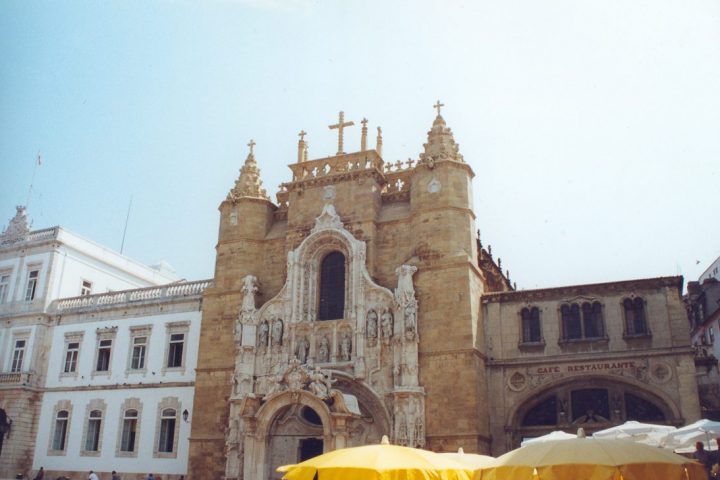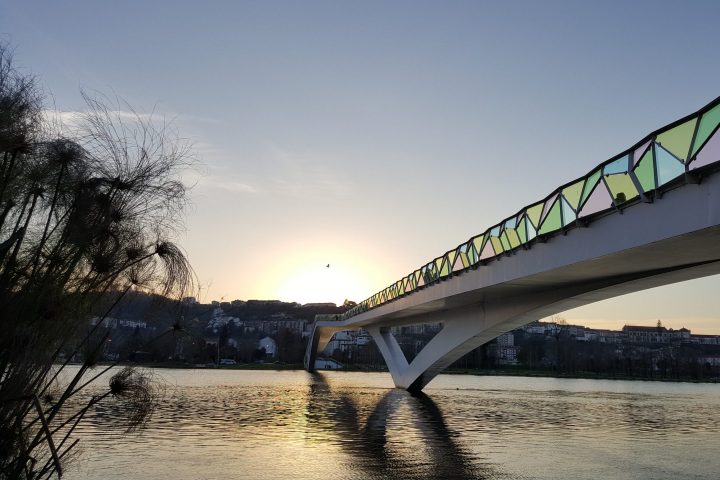For students arriving in Coimbra, and for all visitors, here’s a short guide to the city so that you can get to know the most emblematic points of this city.
Starting the tour in the historic center of Coimbra, right in the downtown area (known as "baixa"), a must-see is the Monastery of Santa Cruz, with the status of National Pantheon, due to the presence of the tombs of the first kings of Portugal, D. Afonso Henriques and D. Sancho I.

Walking along Rua do Comércio, you will come to one of the city’s essential landmarks, which serves as the gateway to the array of narrow streets that characterise and symbolise the high part (known as “alta”) of old Coimbra: Arco de Almedina. It is also symbolic for students who, once dressed, may only pass there with their capes drawn in silence, as a sign of respect. A few meters further up, you will pass the Estátua da Tricana, a symbol of the women of Coimbra. Going up the “quebra-costas” (a street with steps) you will come across the Sé Velha (Old Cathedral), which began to be built when D. Afonso Henriques declared himself King of Portugal and chose Coimbra as the capital of the kingdom. It is in this emblematic location that the Serenata Monumental (Monumental Serenade) is held during the Queima das Fitas, the week of academic festivities that takes place every year in May. Further up, you will find the Machado de Castro National Museum. It houses an important collection of sculptures, paintings and decorative arts, occupying the former premises of the Episcopal Palace of Coimbra (where the old Church of São João de Almedina used to be). On the lower floor of the Museum is the Roman cryptoporticus, with a vast network of galleries and connecting spaces. This space previously supported the Roman forum. There is also the old Episcopal Palace, with multimedia rooms and temporary exhibitions, and the new building, which houses a large part of the museum’s collection, also including a terrace with views of the houses.
Next up is the Sé Nova, built in the 16th century, which was the first Jesuit college in the world. It is also a place that marks the academic path, as it is where the Benção das Fitas ceremony takes place.
Nearby is the Porta Férrea, which gives access to the University’s Pátio das Escolas and the Joanina Library. This is where Coimbra students draw their capes for the first time on the night of the Serenata Monumental. As a place to rest and stroll, there is the Botanical Garden not far away. A place where you can find collections of plants from various parts of the world and where endangered species are preserved in their natural habitat.
A little further up, you will find Penedo da Saudade, now a garden, whose name comes from the legend that D. Pedro used to visit the place and mourn the loss of his beloved Inês. In this garden, you can find tombstones with verses, busts of poets and tributes from former students to the city. Opposite this garden is the Penedo da Saudade Cultural Centre, created in 2019 by the Presidency of the Polytechnic of Coimbra, which offers a program of cultural initiatives throughout the year, open to the community.
As you walk down the city streets towards the Mondego River, you come across the Parque Verde do Mondego, an area of over 400,000 square meters, with walking paths and cycle paths, a skatepark, a sand area for beach volleyball, sports and exhibition pavilions, and facilities for canoeing and paddle boarding, among others. It is also on the banks of the Mondego that freshmen are baptised during the Latada week, which usually takes place in October and marks the start of the school year and the welcoming of new students.
Crossing the river via the Pedro and Inês pedestrian bridge, you will come across the Santa Clara-a-Velha Monastery, whose ruins are one of the first examples of Gothic architecture in the country.

The visit to the monastery includes the ruins and a museum that includes the convent’s archaeological remains. The monastery was founded by Queen Isabel in the 14th century, who lived there after the death of her husband, King D. Dinis. The monastery was abandoned in the 17th century due to the constant flooding caused by the Mondego River. To replace it, a new monastery was built, the Santa Clara-a-Nova monastery, on the top of the Santa Clara plateau. Built in the Baroque style, the city’s patron saint lies there in the original tomb dating back to the 14th century, and in honor of whom the Holy Queen’s festivities are held every two years in Coimbra. The monument is open to visitors and has a viewpoint with a fantastic view over the city.
On the way down, you will also find the Convento São Francisco, which, after a renovation project, reopened in 2016 as a cultural venue with a diverse program of concerts, theatre plays and dance performances. Next door is Quinta das Lágrimas, a place full of trees and ancient fountains, with a 19th-century palace and neo-Gothic ruins. Here, you can get up close and personal with the setting for one of Portugal’s best-known love stories, the forbidden love between the Portuguese prince D. Pedro and a Galician maid, D. Inês de Castro, in the garden of Quinta das Lágrimas. The famous Fonte das Lágrimas symbolically evokes the tears and blood shed by Inês de Castro when she was tragically executed in 1355 by order of D. Pedro’s father, King D. Afonso IV.
Make sure to visit the Mata Nacional do Choupal. Covering an area of 79 hectares, this is a favorite spot for outdoor activities, with trails for running, walking and cycling, as well as a picnic area and a café. You can walk from the city center to the Mata, following the path along the Mondego River.



